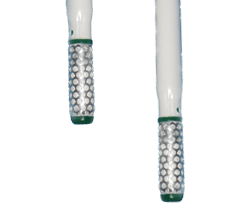Tensiometry is a structured and documented technique, based on measuring water tension in the soil
In other words, the succion that roots need to apply to extract water from the soil. The drier the soil, the higher its tension.
The soil is a complex matrix, behaving like a wick or a pump, moving water, as long as the pump is primed. Tensiometric sensors are vaccuum guages, plugged on this natural pump, observing it, according to a precise instrumentation protocole.
The avantages of Tensiometry
• The unit is known : cbar or kPA.
• Universal measure of tension, or matrix potential or difficulty to extract water, or water availability.
• Operationnal in almost all situations of soil, crop, irrigation mode, without necessity to calibrate the soil.
• Tension on a range 0-239 cb, appropriate indicator in irrigated soils.
The tensiometric sensors are easy to install to get a good contact soil / sensor, allowing tension to equilibrate naturally beetween soil and sensor. Sensors are installed at 2 to 4 dephts, times 3 to 4 repetitions. As a minimum to adress the heterogeneity of humidity in cultivated soils under irrigation.
Monitor, connected to 1 or 2 packs of 8 sensors is automatically registering / transmitting the measured soil tensions.
A basic pack is classically composed of 1 soil temp sensor + 6 Watermark sensors + 1 air temp. 16 different preentations are proposed. Add-on devices (explicative, not deciding) : 1 rain guage and/or watermeter.
Tensiometry is pertinent, rustical, reliable, accurate, affordable, cost effective.
Tensiometry has progressed more with the Monitor since 2004, than during the previous decades.
For 2 reasons :
1) continuous readings, instead of maunal discontinuous readings.
2) minimum of 3 repetitions to give statistical strengh to decisions.
An interesting progress has been brought by telemetry (transmission of data) since 2007.
On-line graphs show in real time how soils are behaving and allow decisions, several days in advance.
This allows adapt the irrigation planning, a week in advance, Monitoring with one step ahead the events, changes everything.
Measuring tension :
2 types of tools, measuring tension in the soil :
- Watermark sensor measures on a range 0 – 239 cbars, no maintenance, frost resistant.
- Tensiometer measures on a range 0 – 80 cbars. Needs maintenance if tension goes > 70- 80 cb.
The Watermark sensor is a rustical tool, accessible, that doesn’t need maintenance. Simple to use, accurate, pertinent. “Simple to use” does not mean that taking irrigation monitoring decisions can be done without a strong and square technique.
Tensiometry has been used for more than 50 years, and the technique crossed a decisive stage since 2004, with automatic acquisition of measures and a minimum of 3 repetitions thanks to the Monitor (see Data logger for more information).
Application domains :
- Agricultural irrigation
- Transplanted trees
- Portance and stability of soils
Agricultural irrigation :
Tensiometry (or measuring the availability of water in the soil) is a universal technique that allows monitor all kind of irrigation systems, on all crops, in almost all kind of soils, under all kinds of climates.
Tensiometry allows the irrigation manager to observe and handle his own irrigation season with classically 12 to 20 decisions, adapting to the context soil, crop, climate.
Examples, testimonials, results:
In fruit production, a professional management with Monitor costs 20 to 30 kg of fruits/ha/year with the hope of gaining a size is 2 to 5 T/ha/year and savings of 20 to 50% in drip, for example.
- On melon : gain in yield and water saving.
- On vegetable seeds : better results and savings.
- On cereals : the cost is 1 quintal / ha / year with a hope of double gain, with optimization of the m3 used.
- On corn, the economy in non-limiting conditions, is 1.5 irrigation.
On a hundred different irrigated crops, which we and our customers follow, same kind of observation.
Resumption of transplanted trees & irrigation management
Monitor Watermark (in underground version) make it possible to follow the exit of the roots of the transplanted mound and to control the urban watering.
Geotech
Comfort of buildings subjected to swelling-shrinkage constraints of clays, powered by tension.
Soil lift : the acceptable pressure on a soil, without irreversible deformation, is the counterpart of the depression (or tension) existing in this same soil.
Stability of the slopes : the cohesion of the soil is generated by tension. Important consequence for the safety of the building sites.
Book Extract :
“La tensiométrie pour piloter les irrigations : une gestion raisonnée de la ressource en eau.”
Gérard Tron (SCP), Carole Isbérie (Cemagref), Pierre Chol (SCP)
Following numerous experimental campaigns, this book shows that the monitoring of the evolution of soil water tension offers a global and operational approach to the soil-plant-water system.
This information on the quality of irrigation, and improvements to be made to save water, avoiding excessive water intake, while often improving quantity and quality of production.
Extracts the availability of water in the soil (tension, suction, matrix potential), this observation allows, in real time and without much experience of the soil and/or crop, to monitor the irrigation by :
- water always easily available for the crop
- avoiding clogging
- avoiding percolations
- to benefit from capillary lifts
Publications & internet :
This website aims to initiate to tensiometry, select and give accurate information
32 years of experience allow us to estimate that 3 quarters of the information circulating on the Internet on this subject is has been or approximate, against 1 quarter to updated and of good quality.
